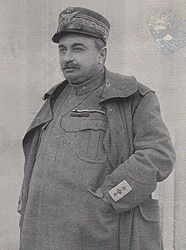Luigi Capello | |
|---|---|
 | |
| Born | 14 April 1859 Intra |
| Died | 25 June 1941 (aged 82) Rome, Kingdom of Italy |
| Allegiance | |
Luigi Capello (14 April 1859, in Intra – 25 June 1941, in Rome) was an Italian general, distinguished in both the Italo-Turkish War (1911–12) and World War I.
During the Italo-Turkish War he served in Cyrenaica and took part in operations near Derna, commanding a column in the final action of the war in October 1912.
During World War I he was the commander of several Army corps and led the Italian troops that captured Gorizia (Sixth Battle of the Isonzo). In June 1917, he reached the apex of his military career when he took command of the Second Army (Italy) and captured the Bainsizza Plateau (Eleventh Battle of the Isonzo). Later, he was removed from command after the Italian defeat at the Battle of Caporetto (October–November 1917). He had failed to check the advance of the Imperial troops (which included for the first time, German troops sent from the Western Front) before being forced to cede his command for health reasons. Capello was blamed for the defeat, and he never returned to service.
Despite the defeat, Luigi Capello was considered one of the best generals for the allies in the First World War;[1] endowed with a dominant personality and a restless, passionate character, the general showed intelligence and tactical and strategic ability. Buoyed by a great offensive spirit, he ordered a series of frontal attacks that cost his troops very high casualties, but accordingly recognized by his perspicacity, the spirit of initiative and analytical ability, he was "by far the best of the commanders of the Italian army[2]".
After the war, he joined the National Fascist Party, from which he was expelled in 1923 due to his Masonic connections. He was later involved in the planning of an attempt to assassinate Benito Mussolini in 1925 along with Tito Zaniboni (it), for which he was tried and sentenced to thirty years jail in 1927. He was released in 1936, after serving nine years.